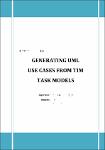| dc.contributor.author | Thong, Huynh Trung | |
| dc.date.accessioned | 2013-07-15T04:13:16Z | |
| dc.date.accessioned | 2018-05-17T03:44:36Z | |
| dc.date.available | 2013-07-15T04:13:16Z | |
| dc.date.available | 2018-05-17T03:44:36Z | |
| dc.date.issued | 2009 | |
| dc.identifier.uri | http://10.8.20.7:8080/xmlui/handle/123456789/220 | |
| dc.description | Other Author: Lam, Ha Minh | en_US |
| dc.description.abstract | A use case model pictures the interactions between a user and a system. A UML use case diagram represents use cases in a way that is nowadays familiar to the industry. However, UML use case diagrams show some limitations with respect to the representation necessary for the system's design.
This paper discusses a methodology in which use case descriptions benefit
from the integration of task modelling into the software engineering process. The
paper will also discuss the reasons why task modelling seems a convenient approach
to overcome the current limitations of use cases. To this end, a careful definition of
the information embedded in task models and in use cases has been outlined.
A particular task modelling language is considered here (TIM - Task-oriented
Information Modelling), because of the degree of formalization it exhibits (which
allows easier transfer of information inside the task models to use case diagram). A
plug-in has been designed to allow this transfer from TimBox® (a TIM task
modelling software) to Enterprise Architect®, a UML modelling environment.
Keywords: use case diagram, use case description, task model | en_US |
| dc.description.sponsorship | Tanguy Wettengel, Ph.D. | en_US |
| dc.language.iso | en | en_US |
| dc.publisher | International University HCMC, Vietnam | en_US |
| dc.relation.ispartofseries | ;022000180 | |
| dc.subject | UML | en_US |
| dc.title | Generating UML use cases from TIM task models | en_US |
| dc.type | Thesis | en_US |


